Jackfruit Patholi recipe with step-by-step photos and instructions. Rice wraps with a filling of coconut and jaggery steamed in turmeric leaves. Also, know how to preserve ripe jackfruit.
There are many sweet jackfruit recipes. Jackfruit Patholi or Ponsache Patholi is one of the many traditional jackfruit recipes that are delectable and flavoursome. Do try out this luscious jackfruit patholi recipe.
What is a Patoli?

Patoli recipe is a very traditional Goan recipe. Goan Patoli (singular) or patoleo (plural) are rice flour rolls (kind of wraps) stuffed with a coconut-jaggery filling and steamed in fresh turmeric leaves. The flavour of turmeric leaves is infused in the patolis. Once steamed, the leaves are discarded and the patoli can be eaten plain or with a tsp of ghee. This haldi paan patholi is very aromatic and flavourful.
It is a sweet prepared and offered as ‘naivedhyam’ during festivals like ‘Nagpanchami‘, ‘Gauri pooja‘, ‘Haritalika or Tay‘ along the coastal belt of Konkan and Goa.
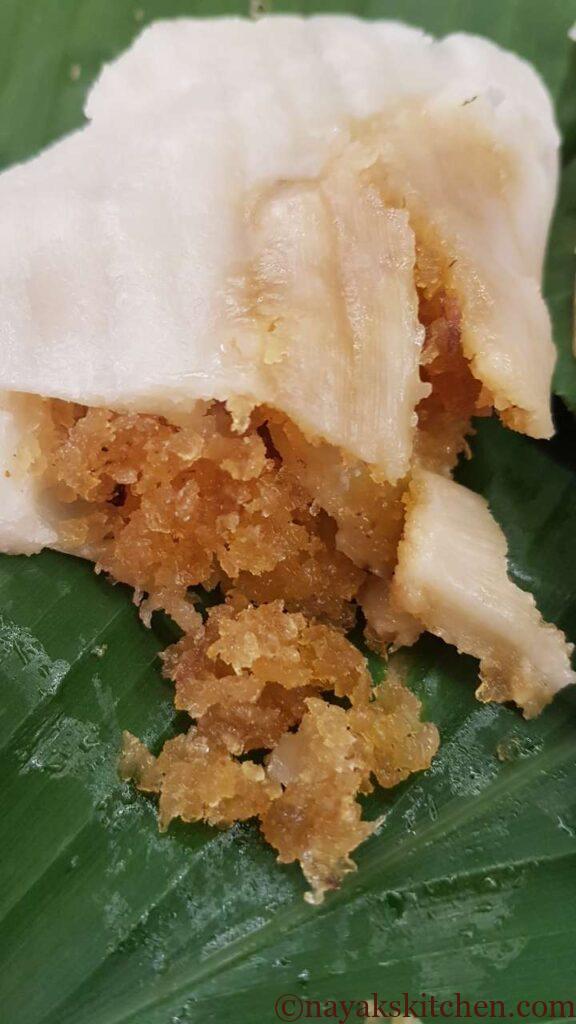
The star ingredient here is the fragrant turmeric leaf which imparts a heavenly aroma to the ‘patoli’ while steaming. This sweet has a close similarity to the well-known ‘ukadiche modak’ but what sets a patoli a class apart are the turmeric leaves or ‘haldi pana’. A patoli cannot be prepared without haldi pana.
This is a very healthy sweet as there is no deep-frying. Also, it is gluten-free with no sugar. Above all, it has the natural sweetness of jackfruit along with jaggery.
To check out my traditional haldi leaves patholi recipe click on the link below.
What is Jackfruit Patholi?
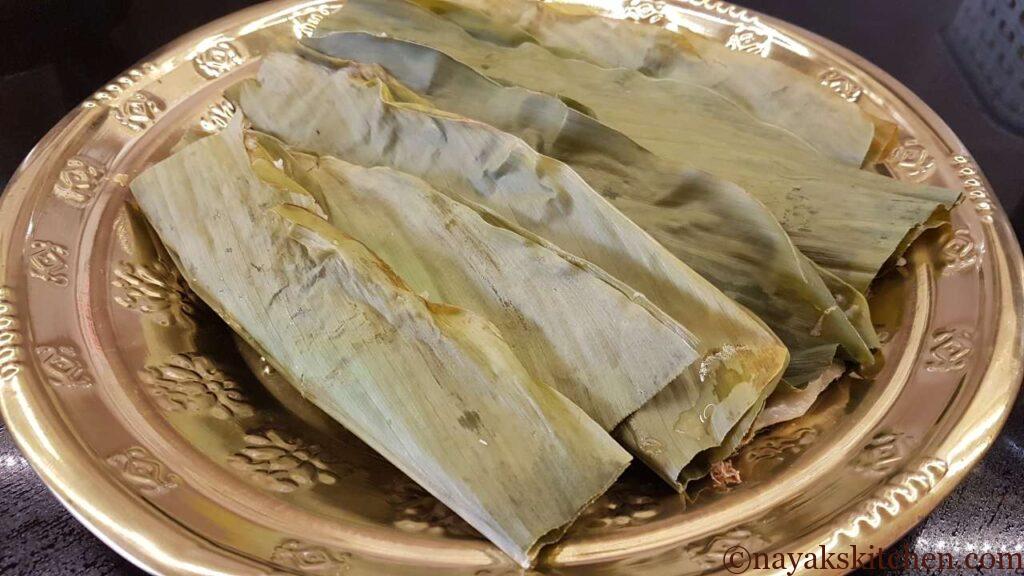
Ponsa Patholi or Jackfruit Patholi is similar to the traditional patholi, however, with a subtle hint of jackfruit. Jackfruit pods (Gare in Konkani) are used to give the rice batter (outer covering) a jackfruit flavour. Moreover, the stuffing remains the same; coconut-jaggery mixture. This variation of patoli using jackfruit tastes awesome.
During summers jackfruits taste delicious and are very sweet. But, once the monsoon sets in, their sweetness reduces and they taste a bit bland. You may not relish them as much. This jackfruit patoli recipe is a great way to use this kind of bland jackfruit.
Turmeric Leaves/Banana Leaves for patholi
Traditionally patolis are prepared in turmeric leaves. Turmeric leaves are called ‘haldi pana‘ in Konkani. Haldi Pana have a distinct aroma and smell. Furthermore, this renders a delectable taste to patolis. Totally heavenly! Also, the goodness of turmeric leaves steeps into the patoli. Moreover, we get the health benefits of turmeric leaves.
The turmeric leaves below are from my garden. You won’t believe but all these were grown in a pot. I harvested almost 25 leaves at the end of the season in September. During the peak season (July-September) the plant in the pot yielded almost 50-60 leaves over a period of time.

Since I had so many leaves I decided to make jackfruit patholis. If, however, you do not have turmeric leaves you can use banana leaves instead.
Types of Jackfruit
There are 2 types of jackfruit :-
- Kapo
- Rasaal
Kapo – The ‘kapo’ panas or jackfruit pods (gare) are firm and dry. Hence, this variety is mostly consumed directly. Also, cleaning it is a tedious job and can turn a bit messy as it has a lot of sap (deek in Konkani). It has many fibres (thread-like strands) to which the pods are firmly attached.
Rasaal – This variety is called ‘Barka fanas‘ in Marathi. The ‘rasaal’ panas has soft and juicy pods (gare). Hence, this variety of panas is mainly used in various traditional ripe jackfruit recipes like the dhonas (jackfruit cake), saath, pansachyo patoleo etc. Also, it is easy to clean as it has less sap. Since, it has very less fibers as compared to a kapo jackfruit, the pods are easy to pluck.
Below you can see the pic of an opened rasaal jackfruit.
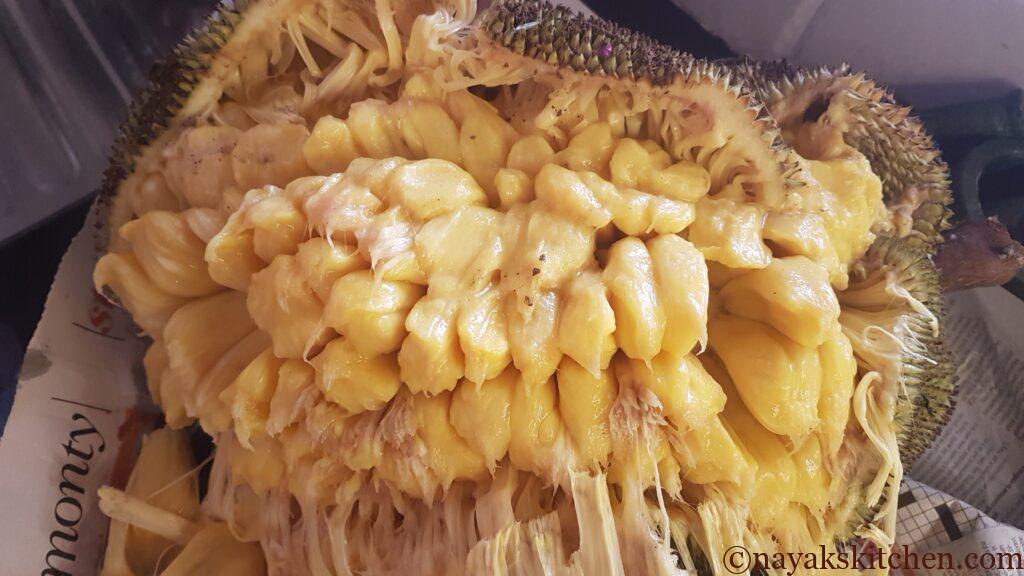
Note:- Use coconut oil or any other cooking oil while cleaning a jackfruit to prevent the sap from sticking to your hands.
Also, do check out my dhonas (jackfruit cake) recipe below:-

How to store jackfruit in the fridge?
Whenever we get a jackfruit at home, it becomes difficult to use it all at once. We eat the ripe jackfruit pods, use them partly in different recipes and then I store the remaining in the freezer.
However, you can store it in the lower fridge section for only a maximum of 4-5 days after which it will start to ferment and go sour. However, it will last for about 3-4 months in the freezer.
To store jackfruit, remove the seeds and place the pods in an airtight glass container. Close the container and keep it in the freezer section. Whenever needed just remove and thaw completely. Enjoy it or use it in desired recipes.
Note: The jackfruit may release some water subsequently, upon thawing. Do not discard it. Use the jackfruit along with its juice.

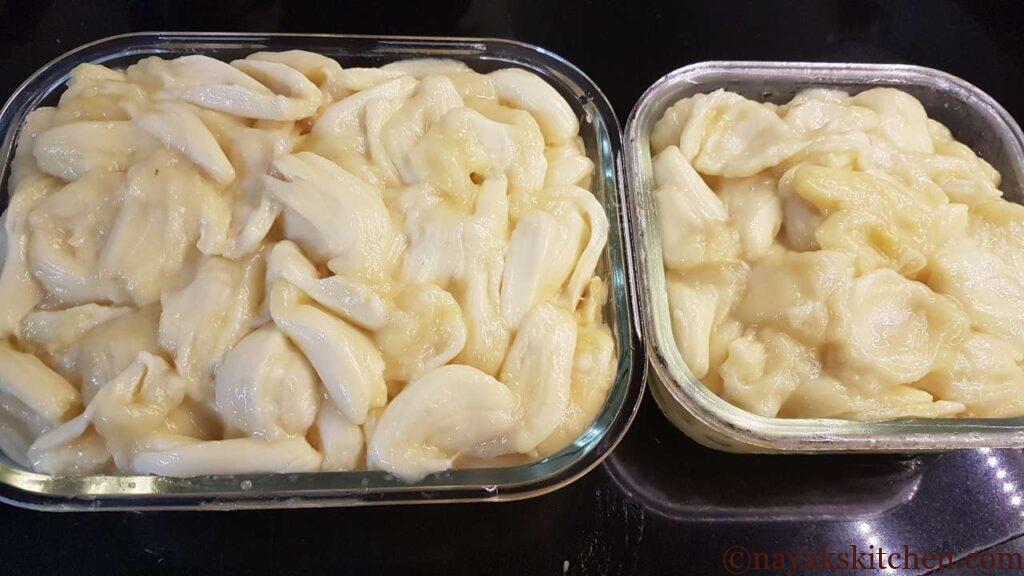
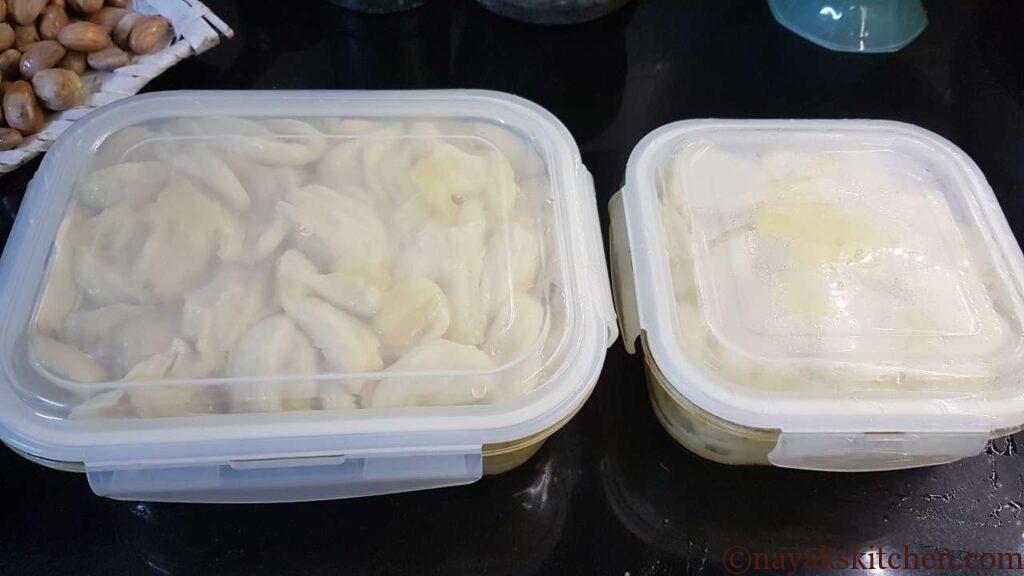
Also, I store them in multiple containers so that I can remove and thaw them in quantities as required. This prevents repeated thawing and freezing which can cause the jackfruit to go bad.
Which rice is to be used for jackfruit patholi?
For the best flavour and aroma use ‘Ambemohar Rice‘. Ambemohar which literally means ‘mango blossom‘ is a fragrant rice variant which has a strong and distinct aroma. It also has a slightly sweet taste. However, you can also use raw rice, sona masoori or ukde Rice.
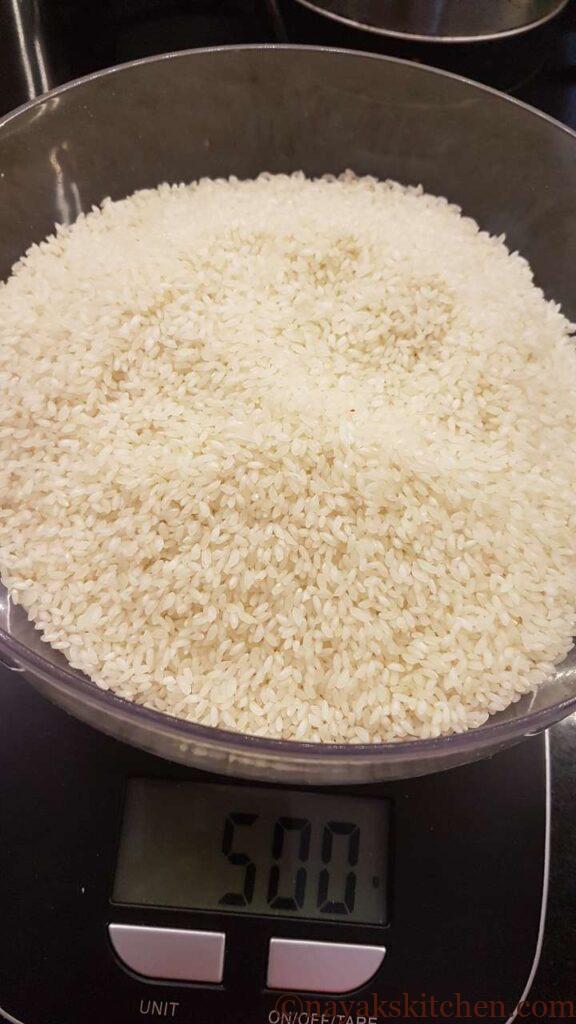
Tips for jackfruit patoli (Ponsache Patholi)
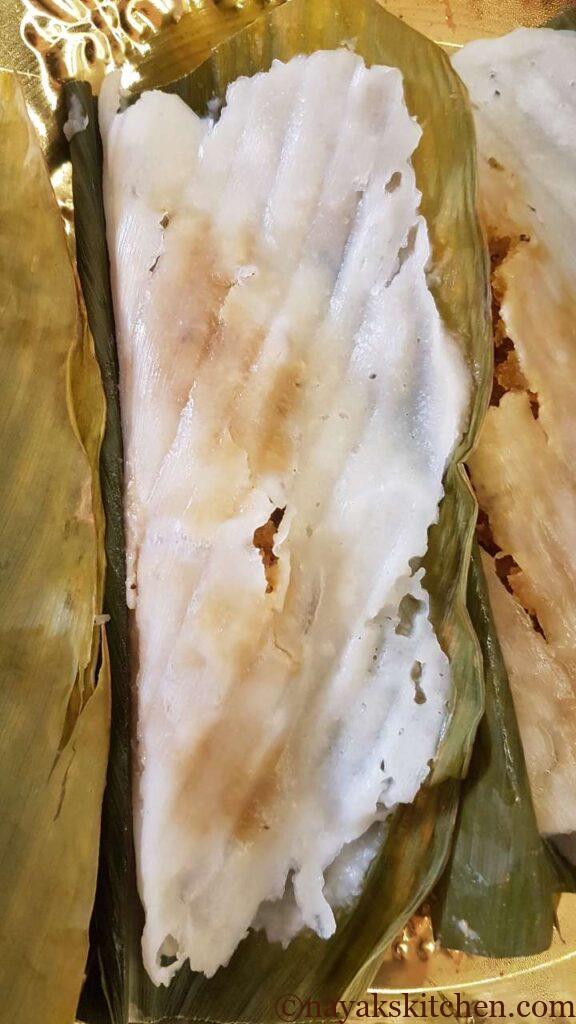
- Preferably use the rasaal variety of jackfruit (called Barka fanas in Marathi) for this recipe.
- Rice – I have used Ambemohar rice for this recipe. You can use raw rice, sona masoori or ukde rice too.
- Jaggery – Use organic jaggery for the best flavour. You can adjust jaggery as per your taste.
- Turmeric leaves substitute – You can use banana leaves as an alternative.
- If your batter becomes runny just add rice flour to make it thick.
How to make jackfruit patholi?
Soaking rice
- Clean the rice and remove any stones. Wash the rice with fresh water. Discard the water. Add water again and soak the rice for 7-8 hours or overnight.
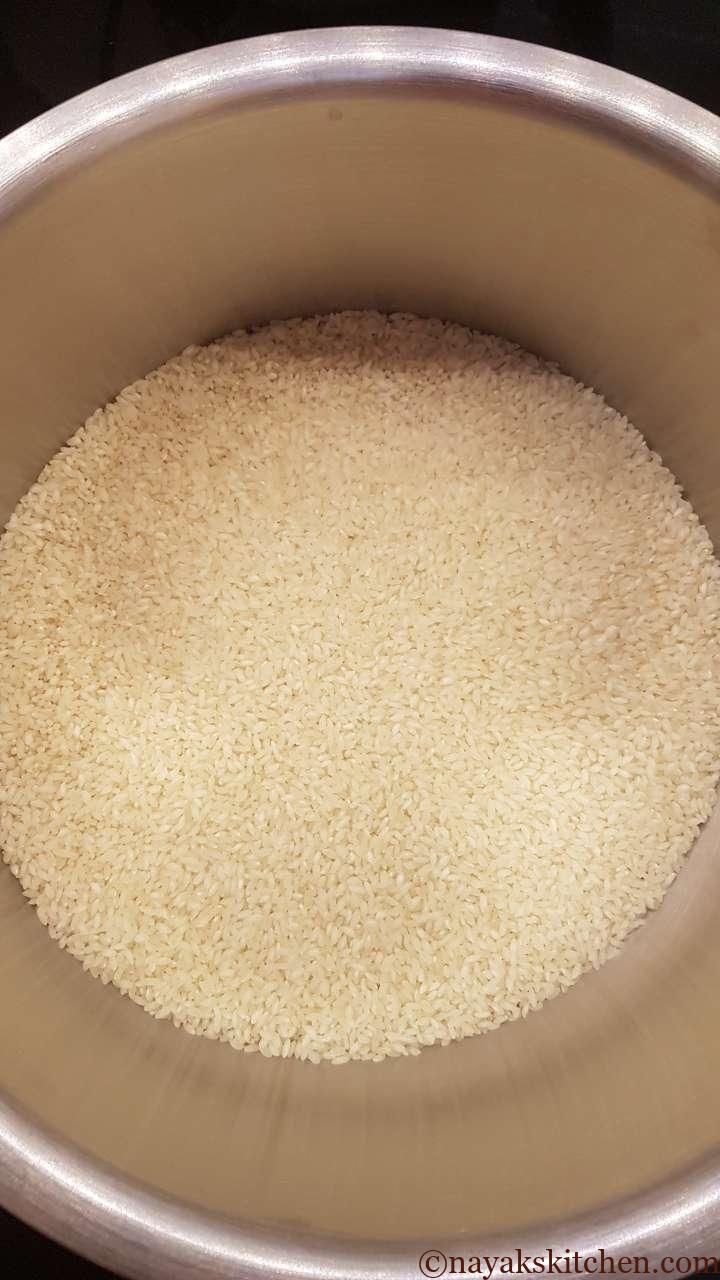
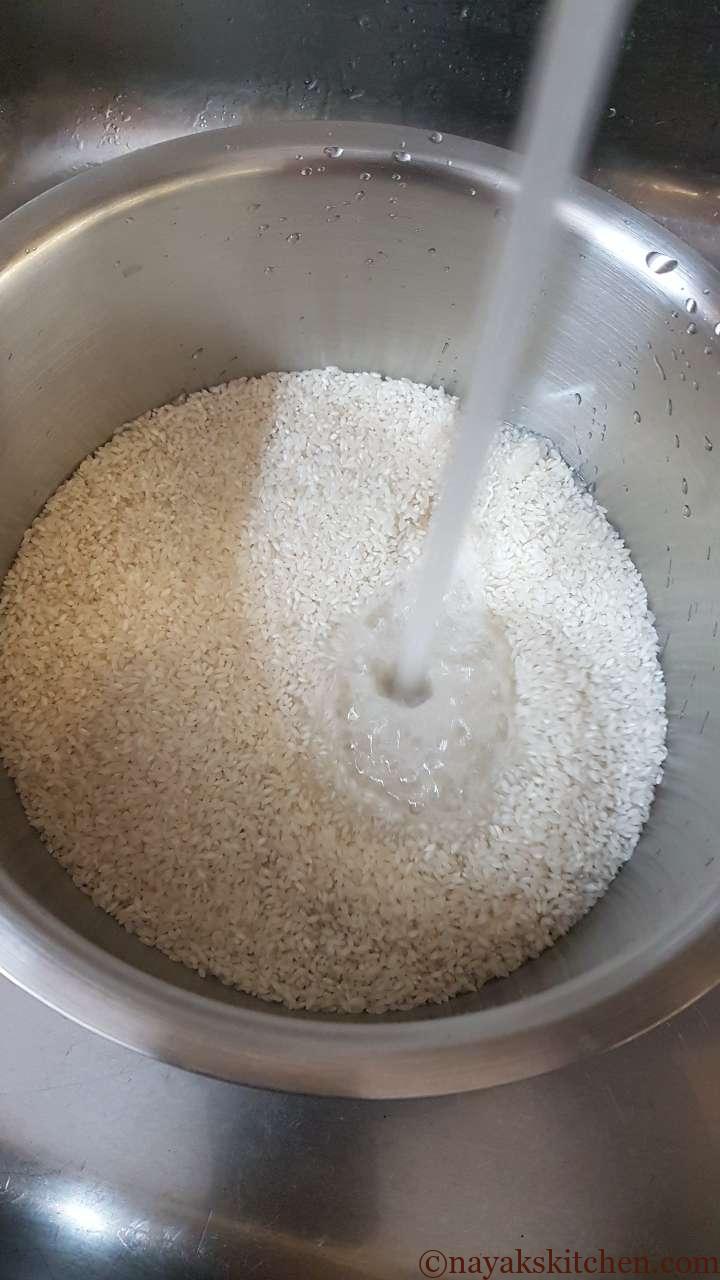
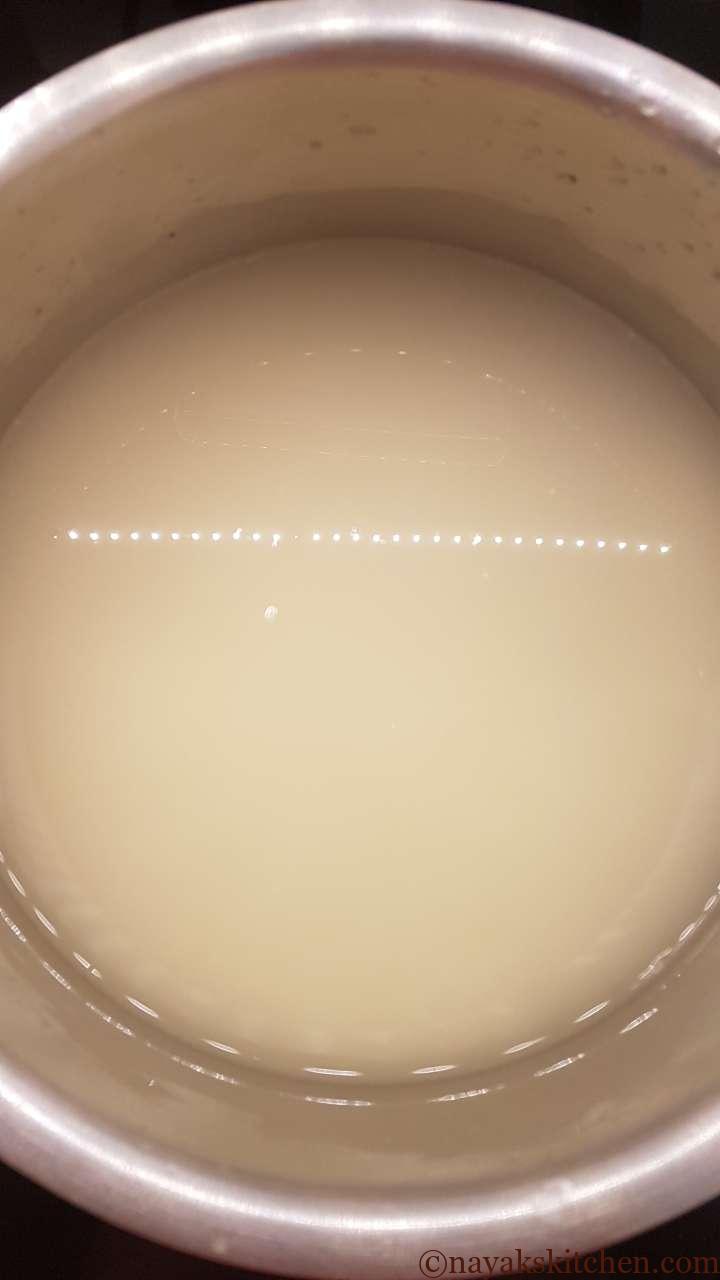
Preparing turmeric leaves
- Wash the turmeric leaves with fresh water and allow them to dry. In addition, you can wipe them dry too. Trim the edges of the leaves. Also, if the leaves are big you can cut them into two or three pieces. Note: You can use banana leaves instead if you do not have turmeric leaves.
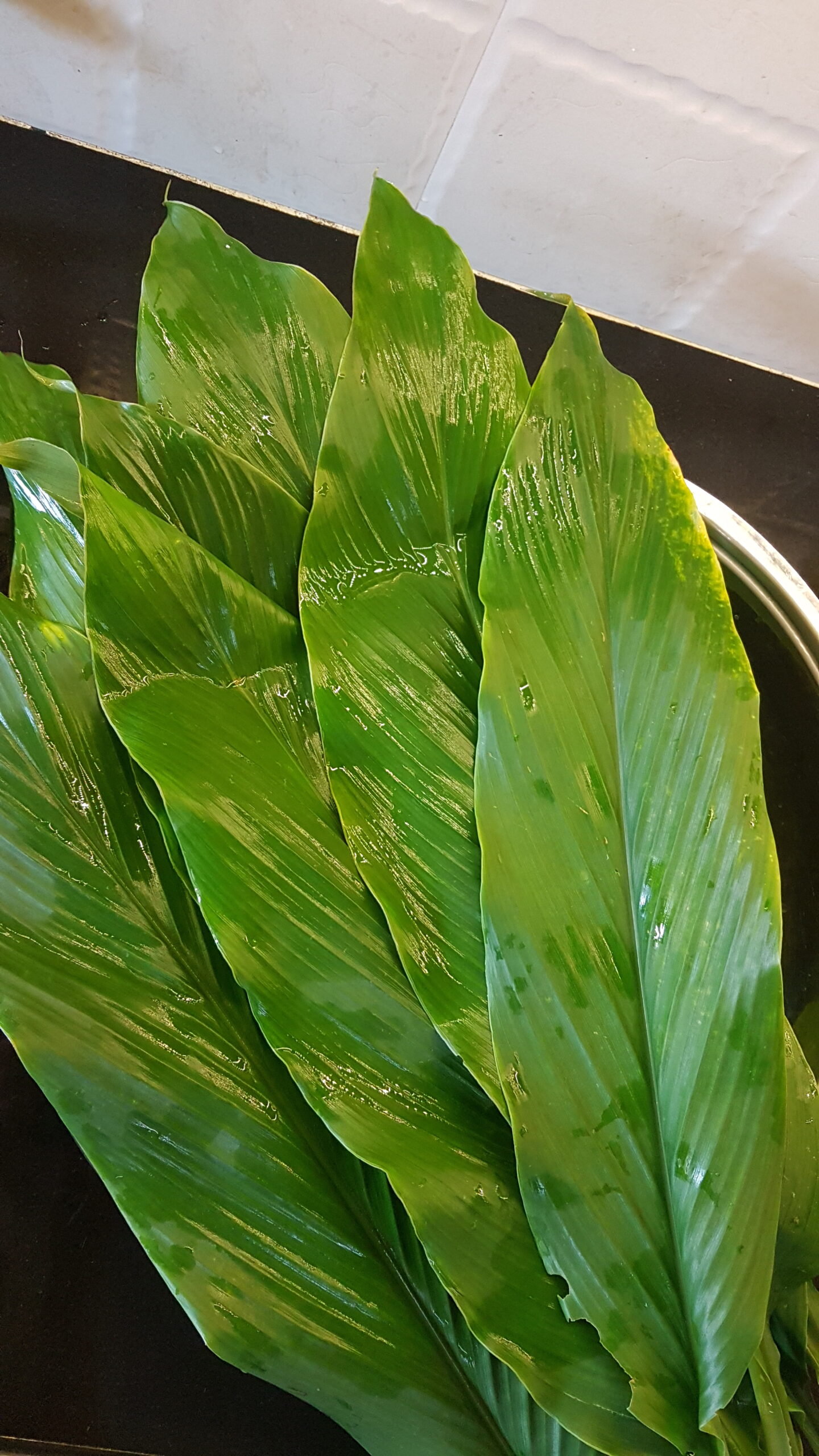
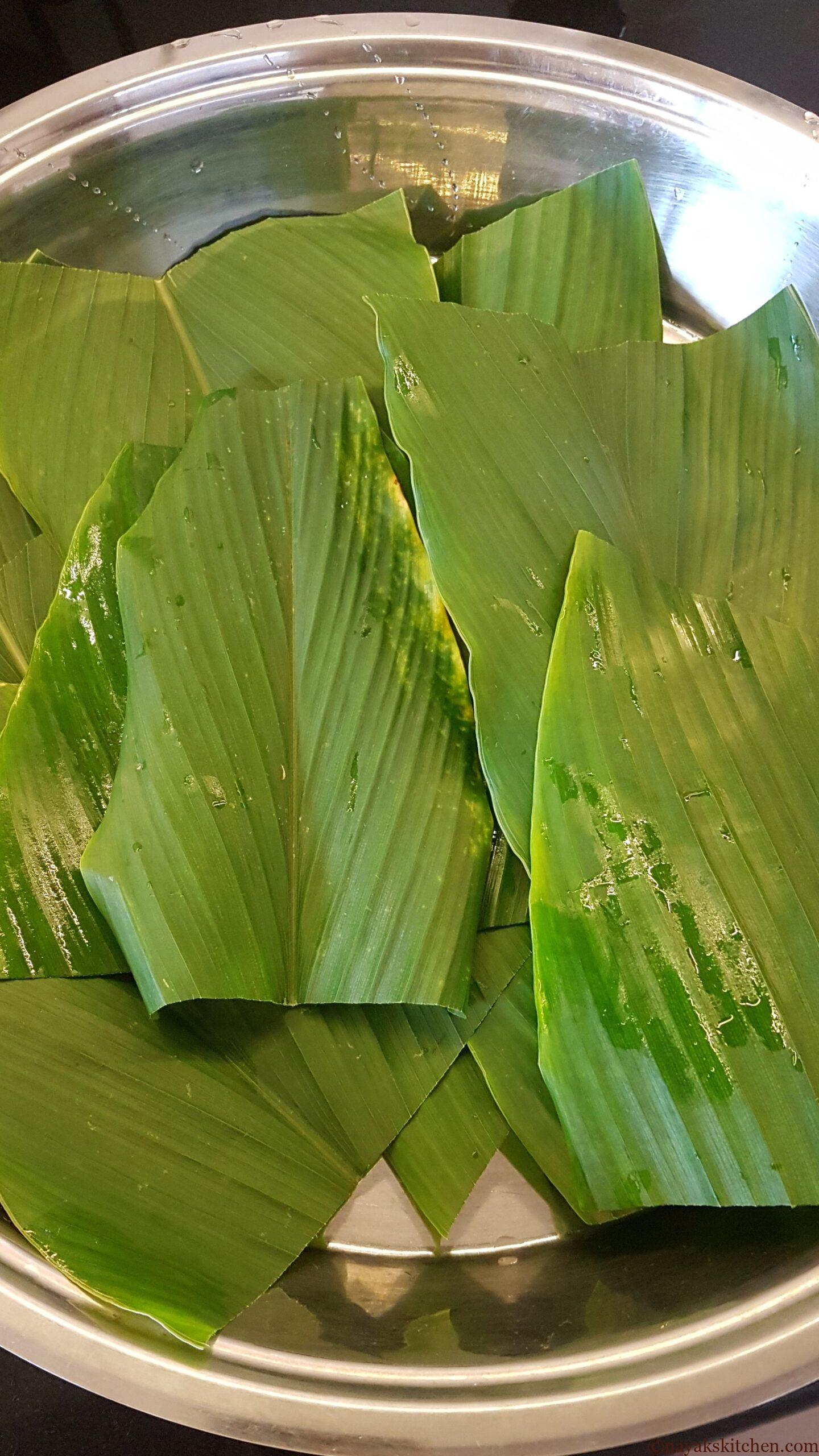
2. Do not discard the trimmed edges of turmeric leaves. You can use them in the steamer while steaming.

Preparing the batter
- Remove the seeds from the jackfruit. Take the pods in a mixie jar and grind them to a pulp or paste.
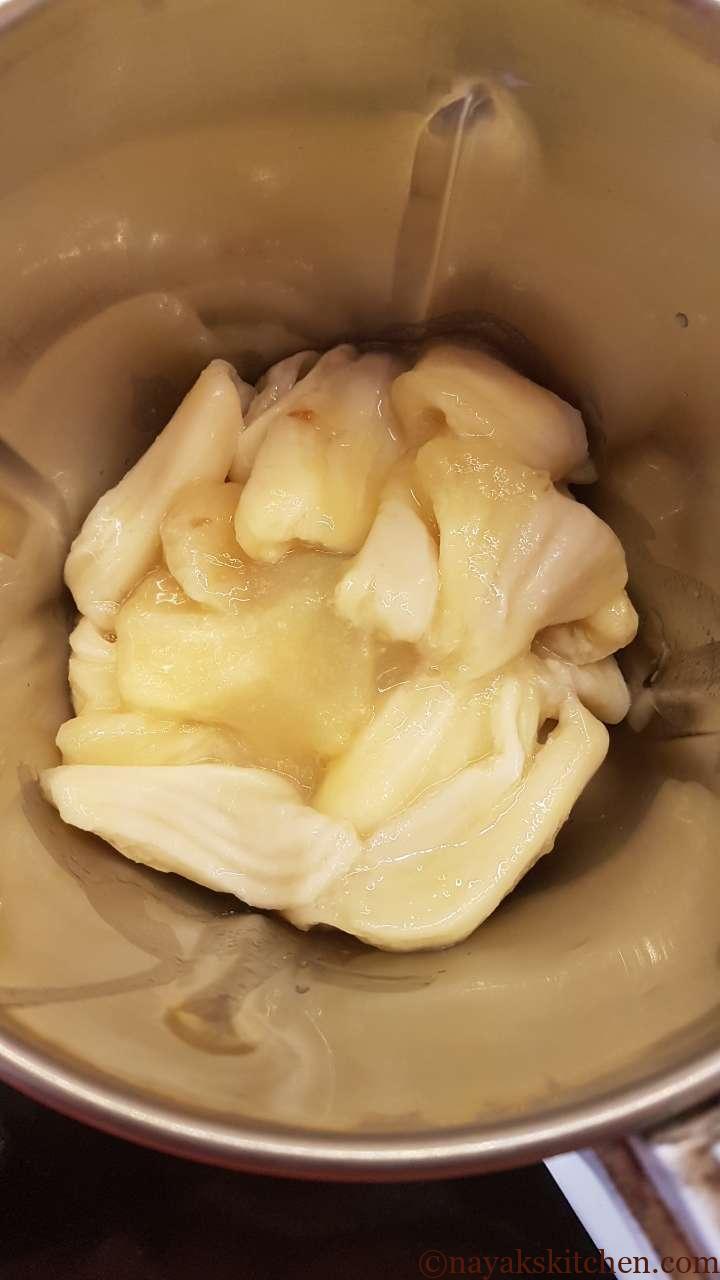
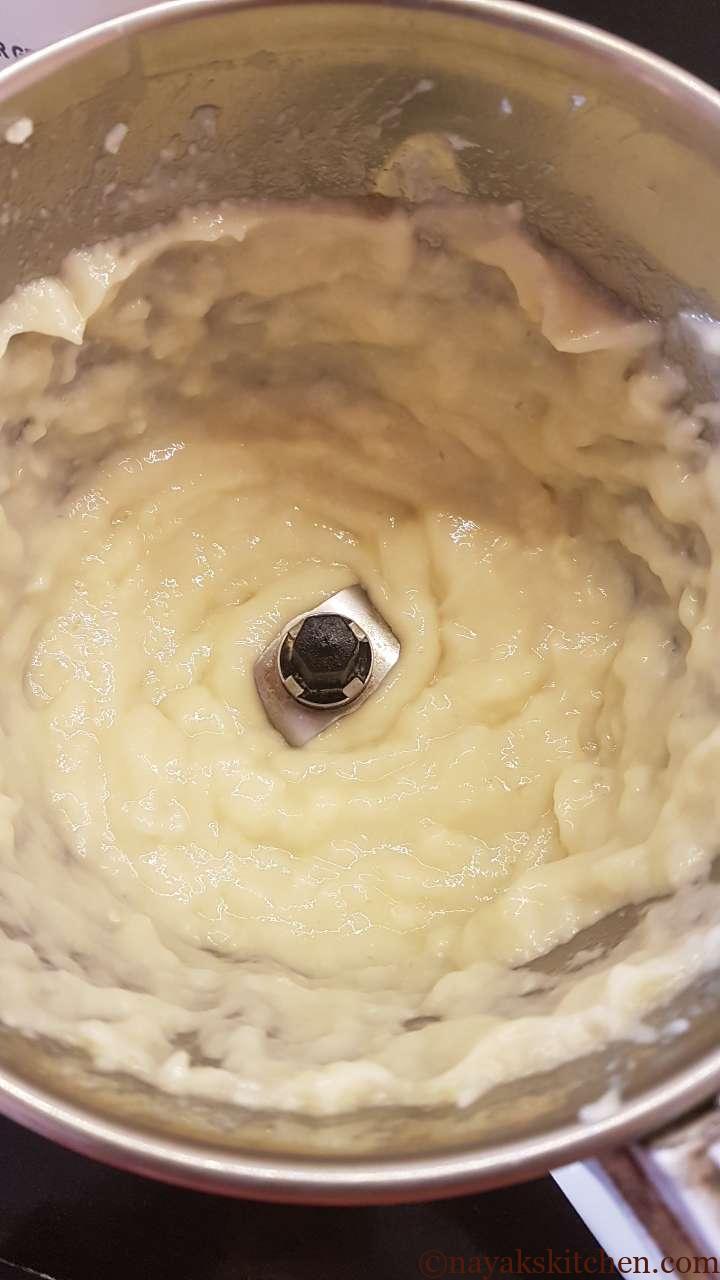
2. Drain the water from the rice completely. Add this rice to the mixie jar. Next, add salt and grind the jackfruit pulp and rice together to a paste. Add 1/4th cup water little by little while grinding. Do not add too much water.

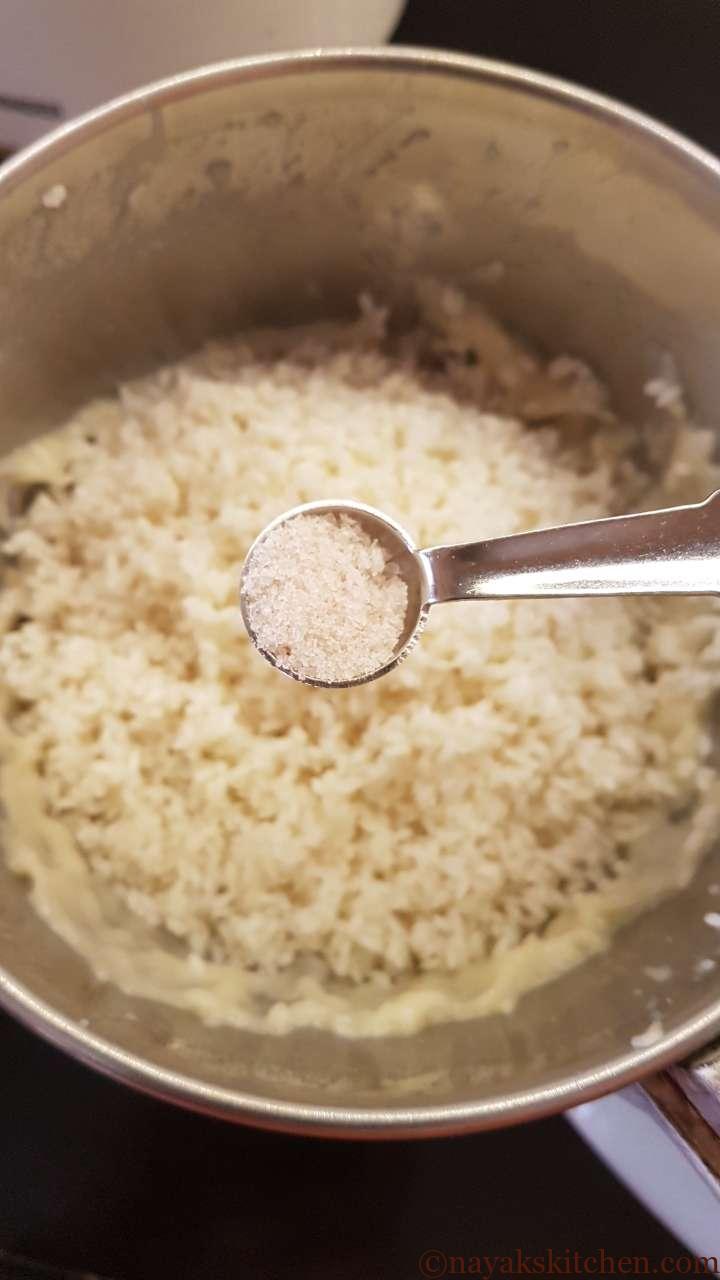
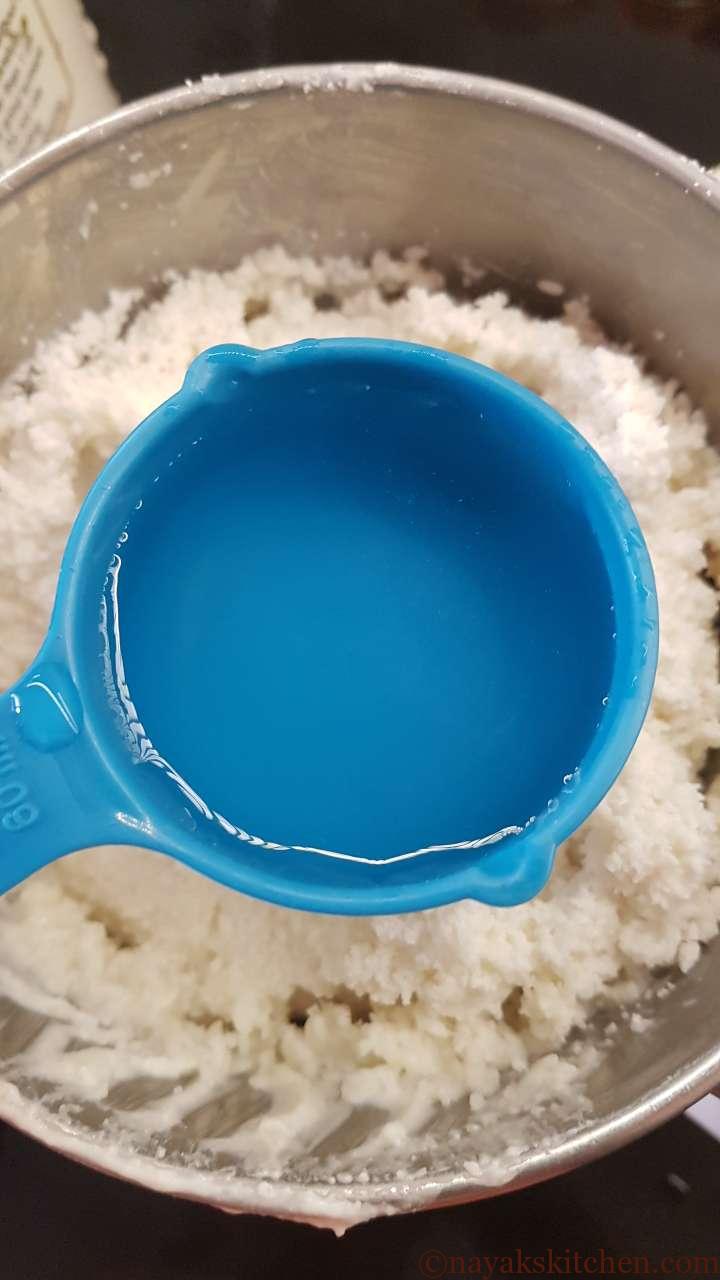
3. Grind the rice and jackfruit pulp together to get a thick batter. You should be able to spread the batter comfortably on the turmeric leaf.


Preparing the stuffing/filling for jackfruit patholi
- Heat a kadhai and add jaggery to it.
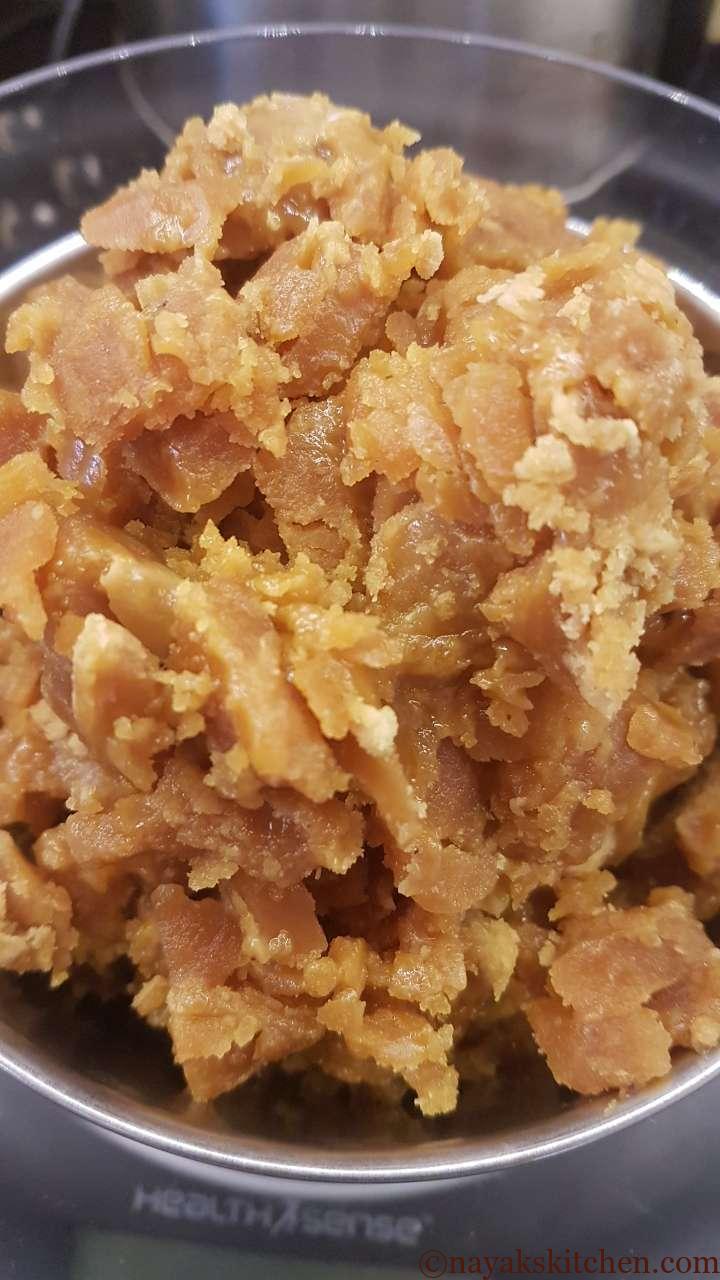

2. Let the jaggery melt till it turns into a liquid.
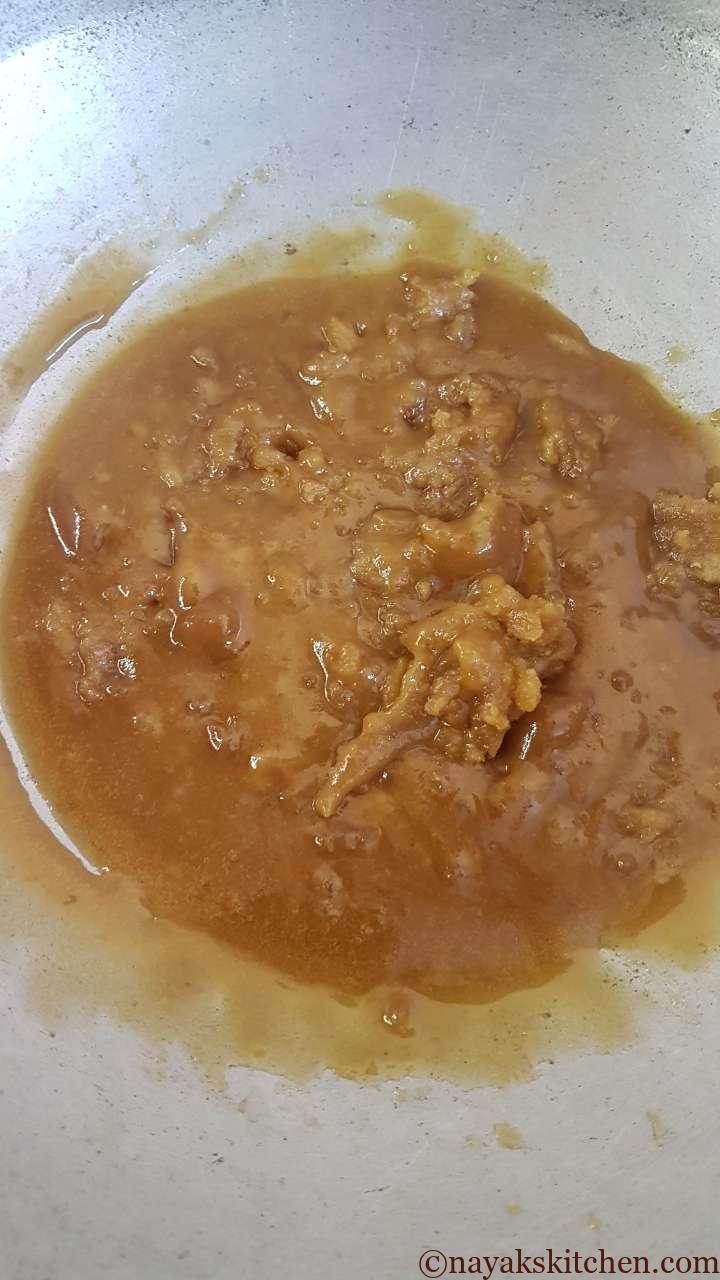
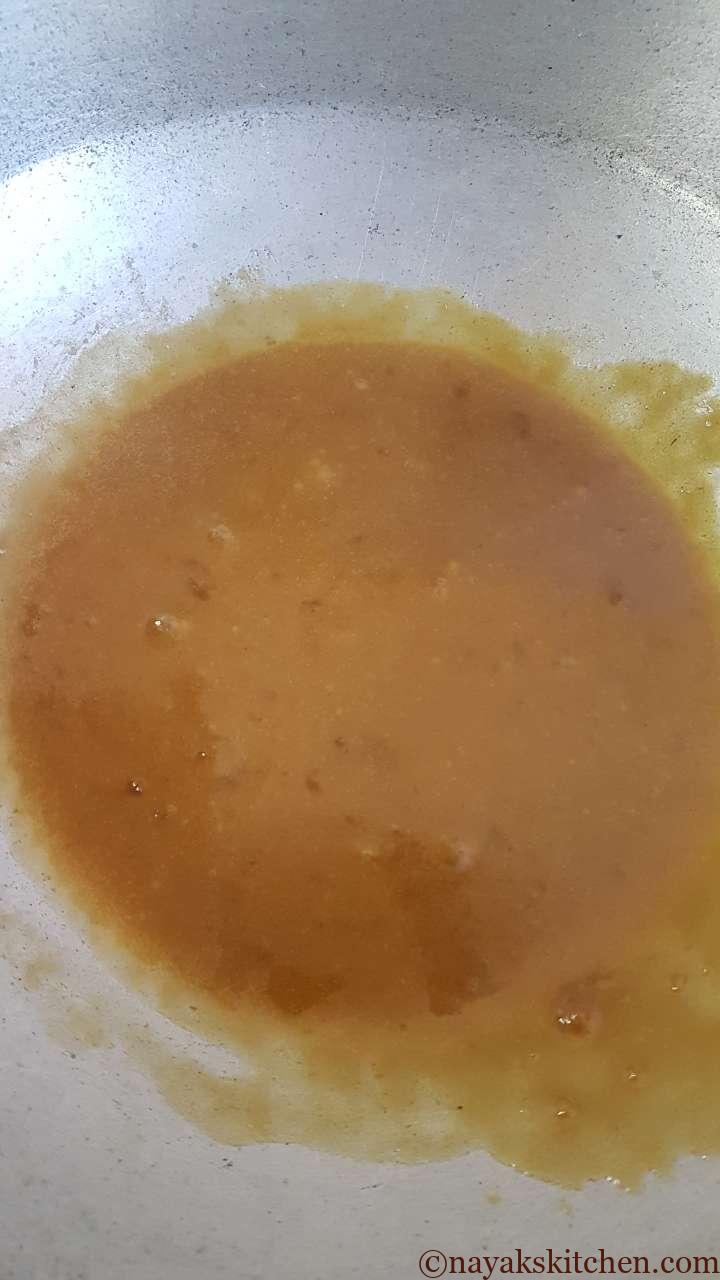
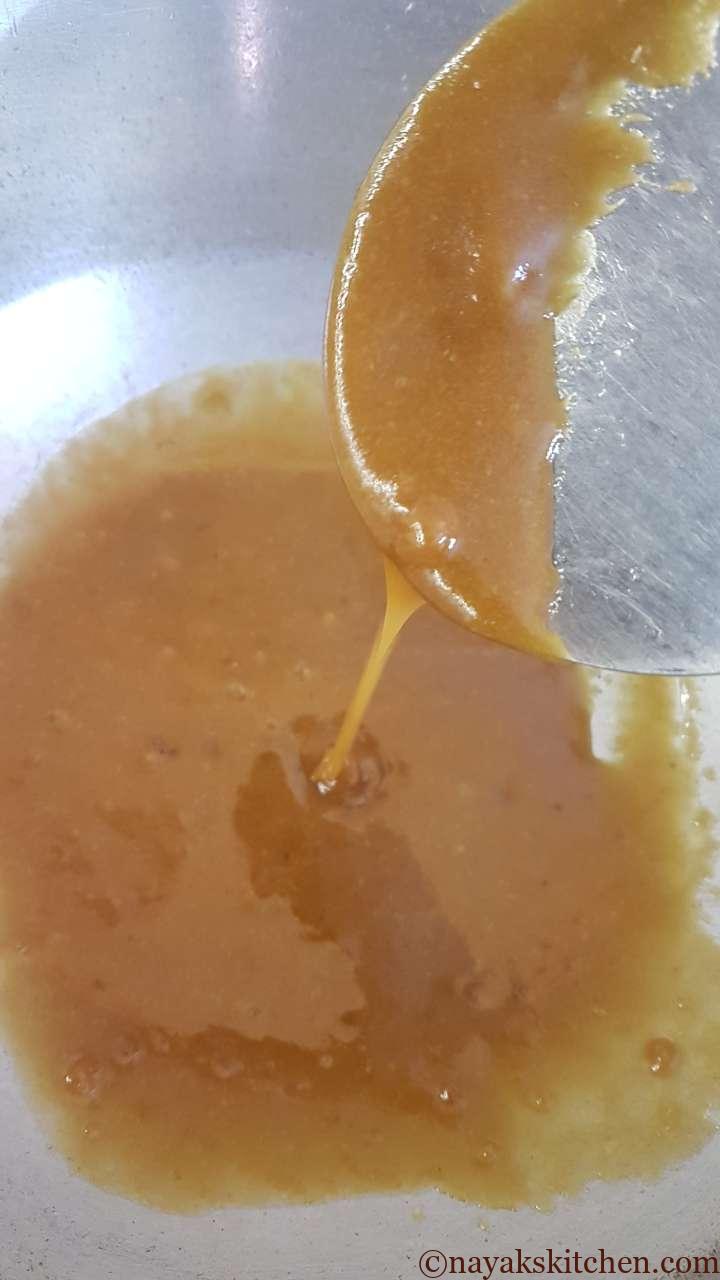
3. Once the jaggery melts, add freshly grated coconut to it. Mix well.
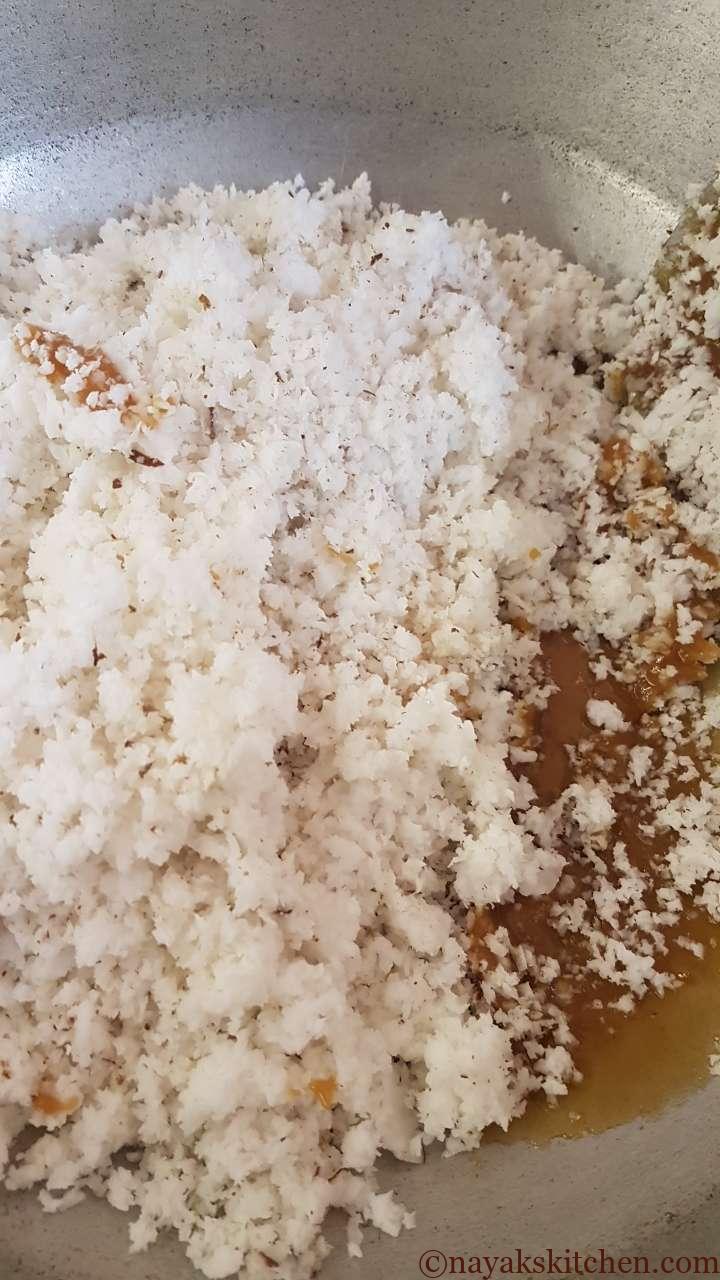
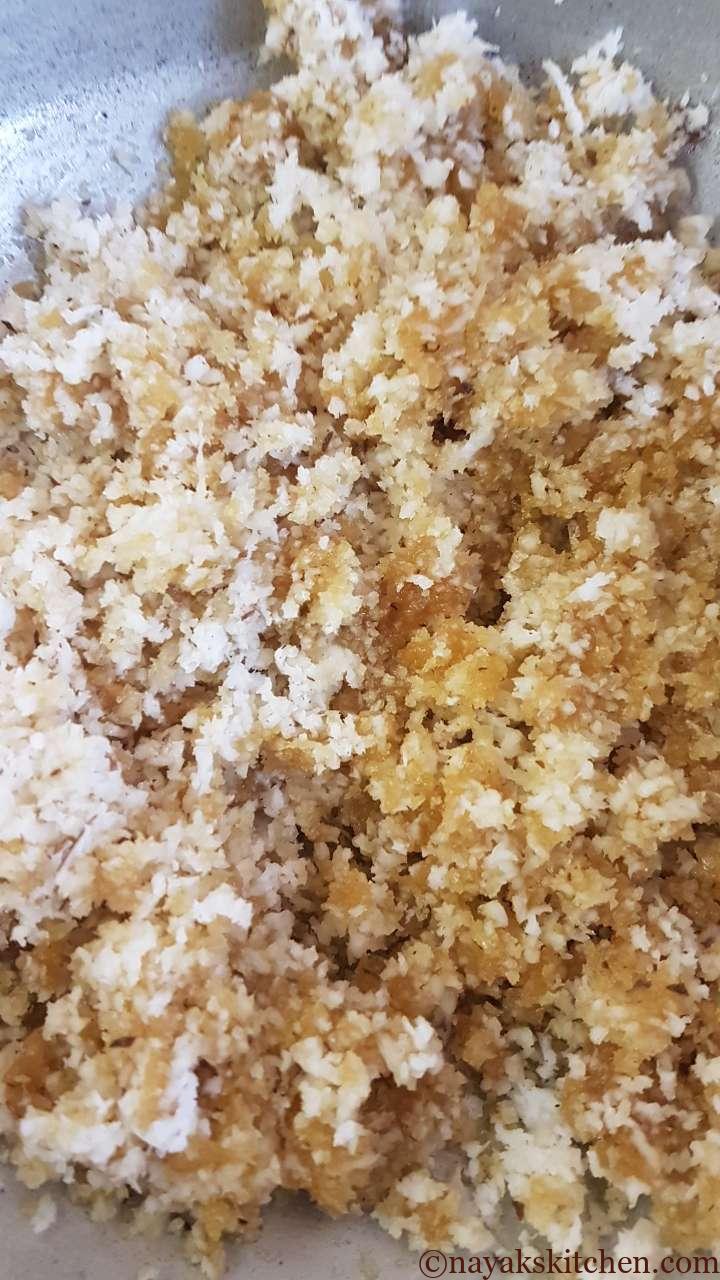
4. Add salt and ghee (clarified butter).
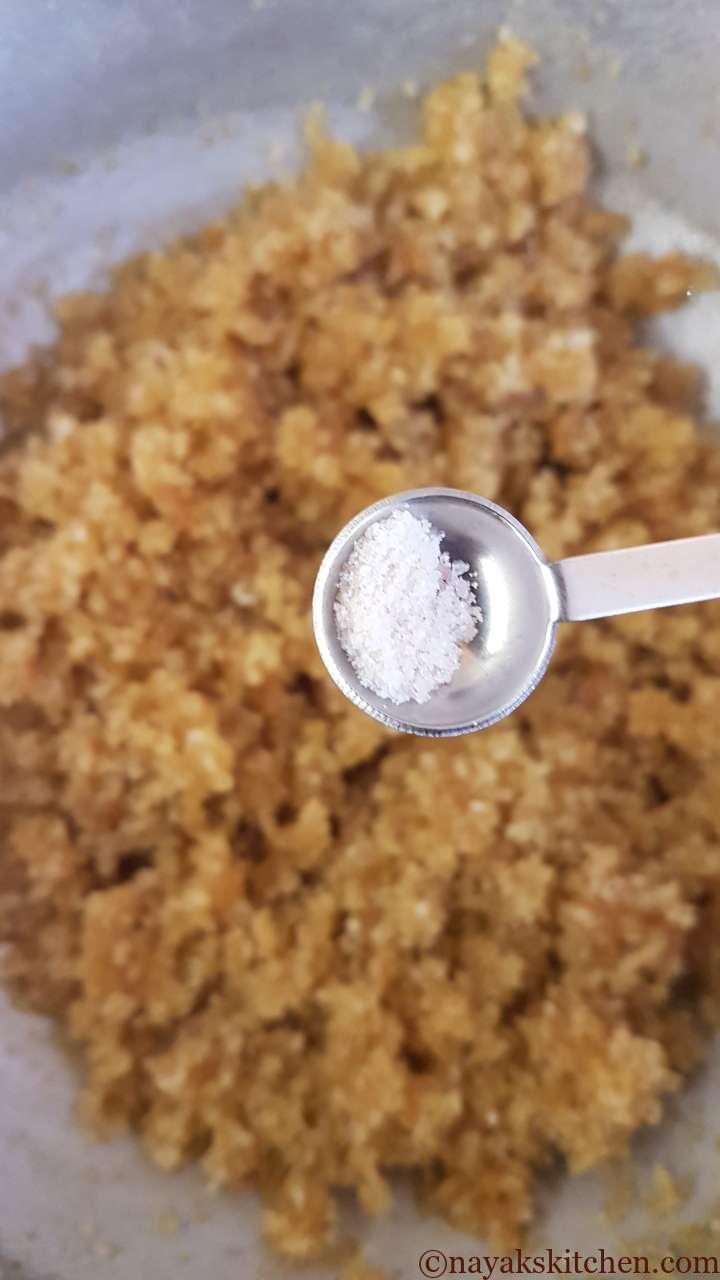
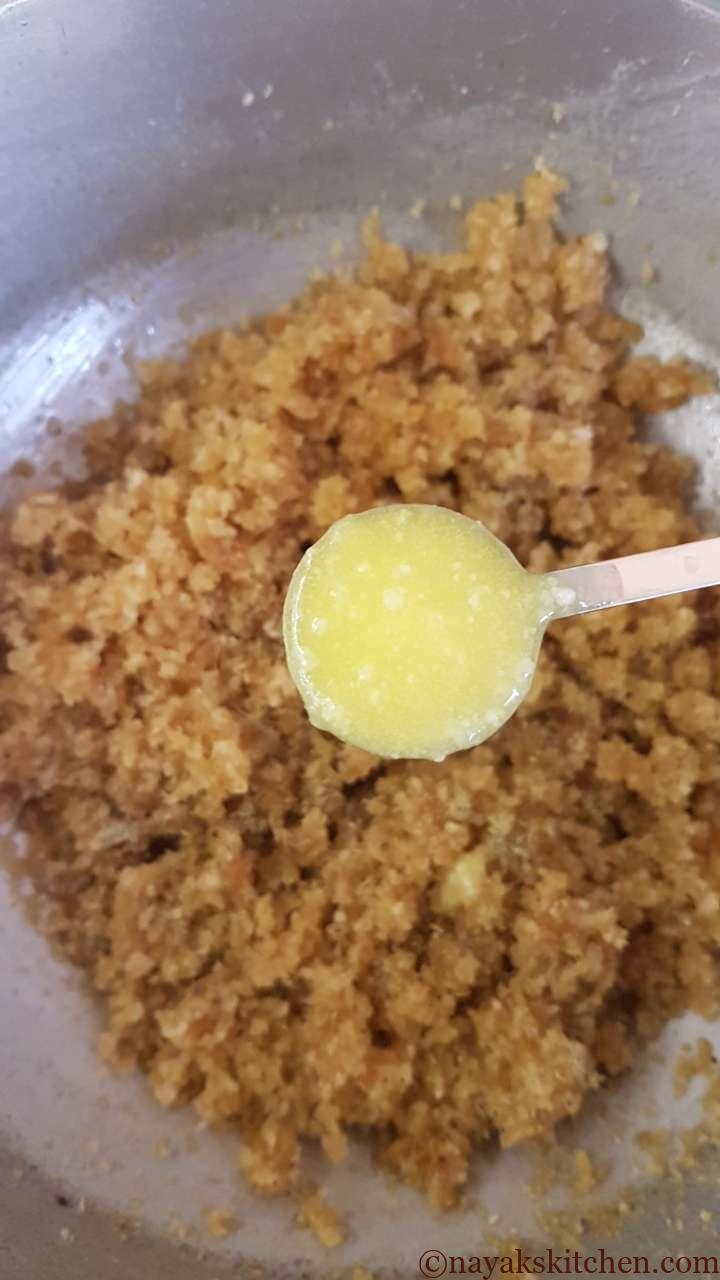
5. Add cardamom powder and cook till everything blends well. Switch off the gas and allow the stuffing to cool completely.

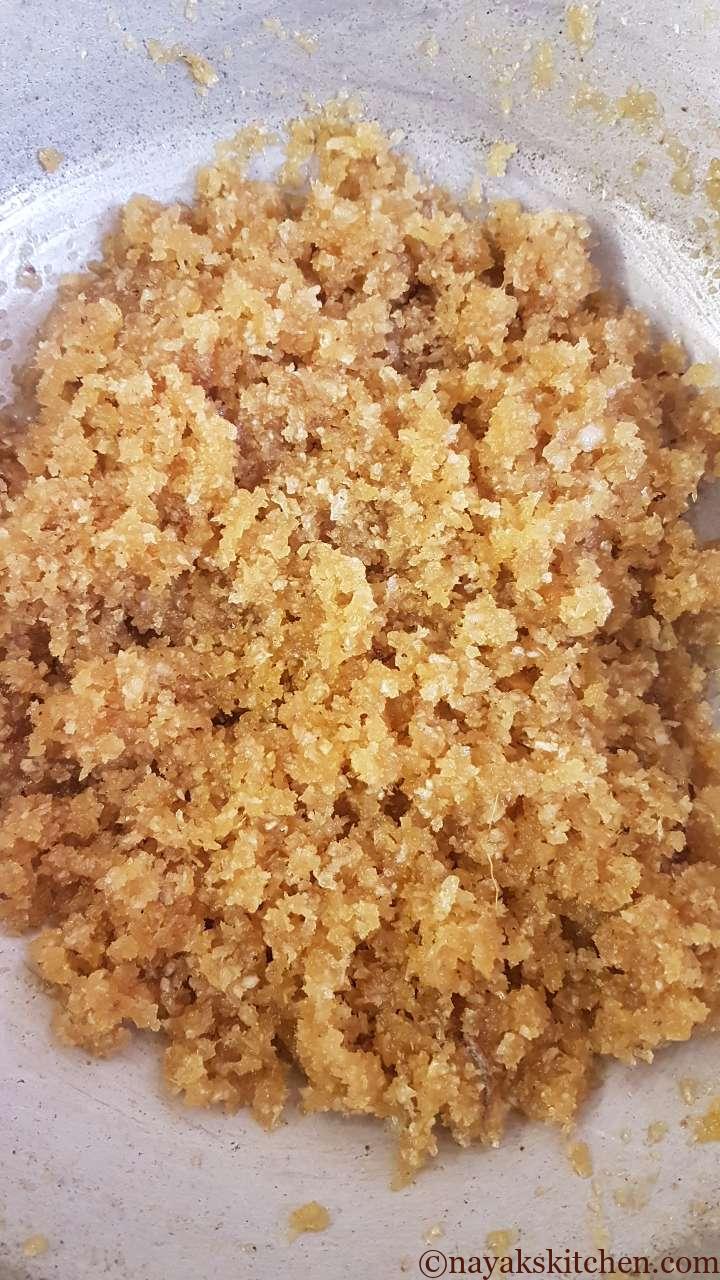
Preparing jackfruit patholi
- Keep all the ingredients ready. Trimmed turmeric leaves, coconut-jaggery stuffing and rice-jackfruit batter.
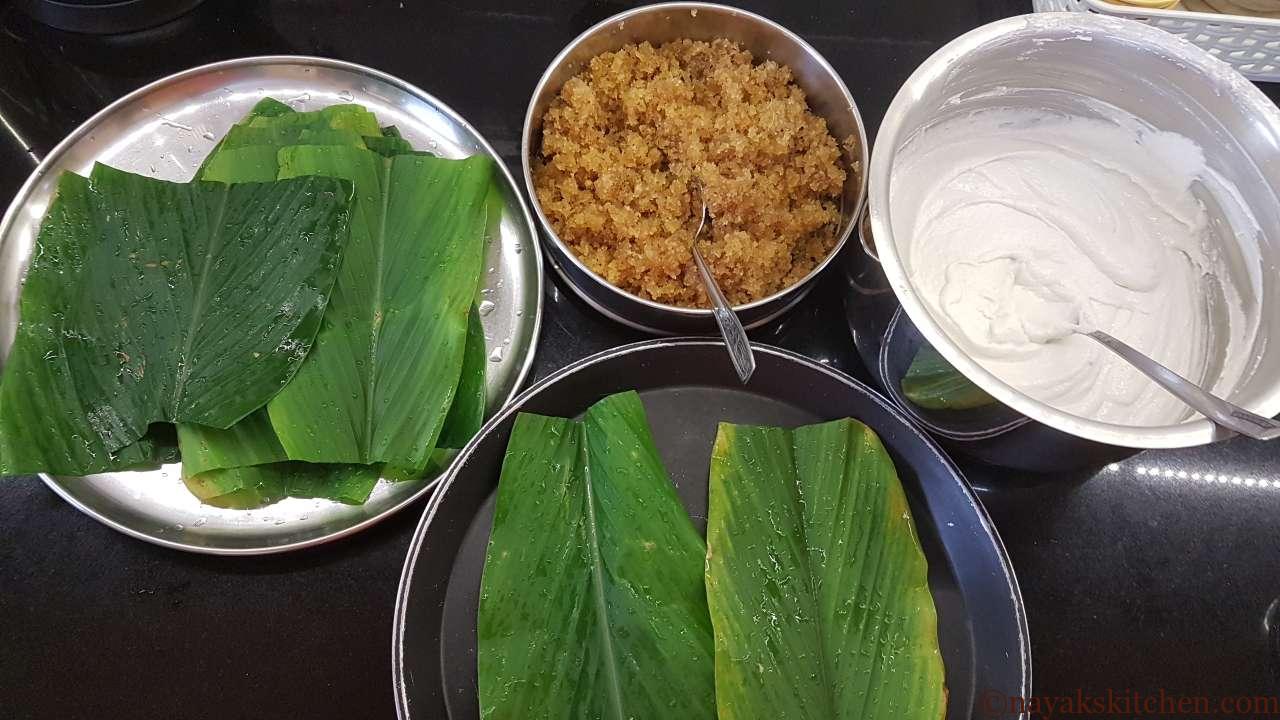
2. Keep water for heating in a steamer while you prepare the patoleo. Add the trimmed edges of the turmeric leaves to the water. You can use an idli steamer. However, if you are preparing a large batch of patoleo you can make your own steamer. To know how to make a steamer of your own check out my patoli post below. Here I have shared a detailed step-by-step method of preparing your own steamer.

3. Smear the leaf with a thin layer of batter, moving from down to the top direction. Place the coconut-jaggery filling slightly towards the right of the leaf.
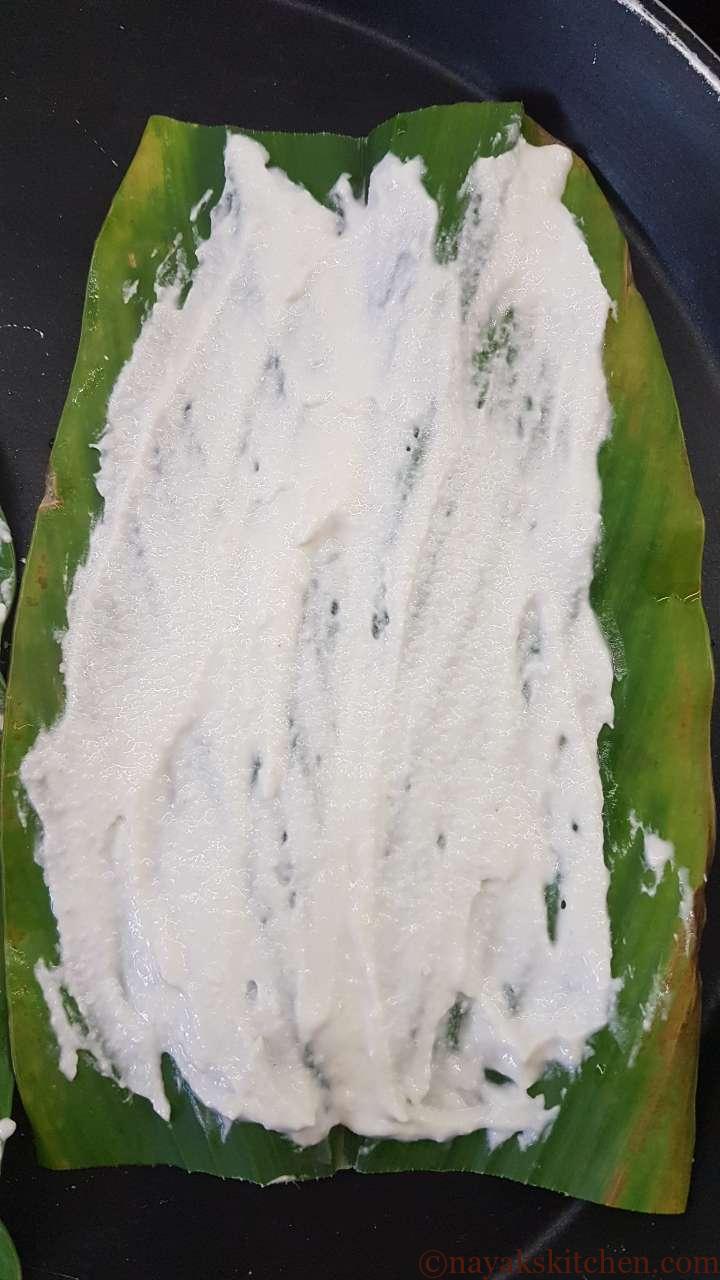
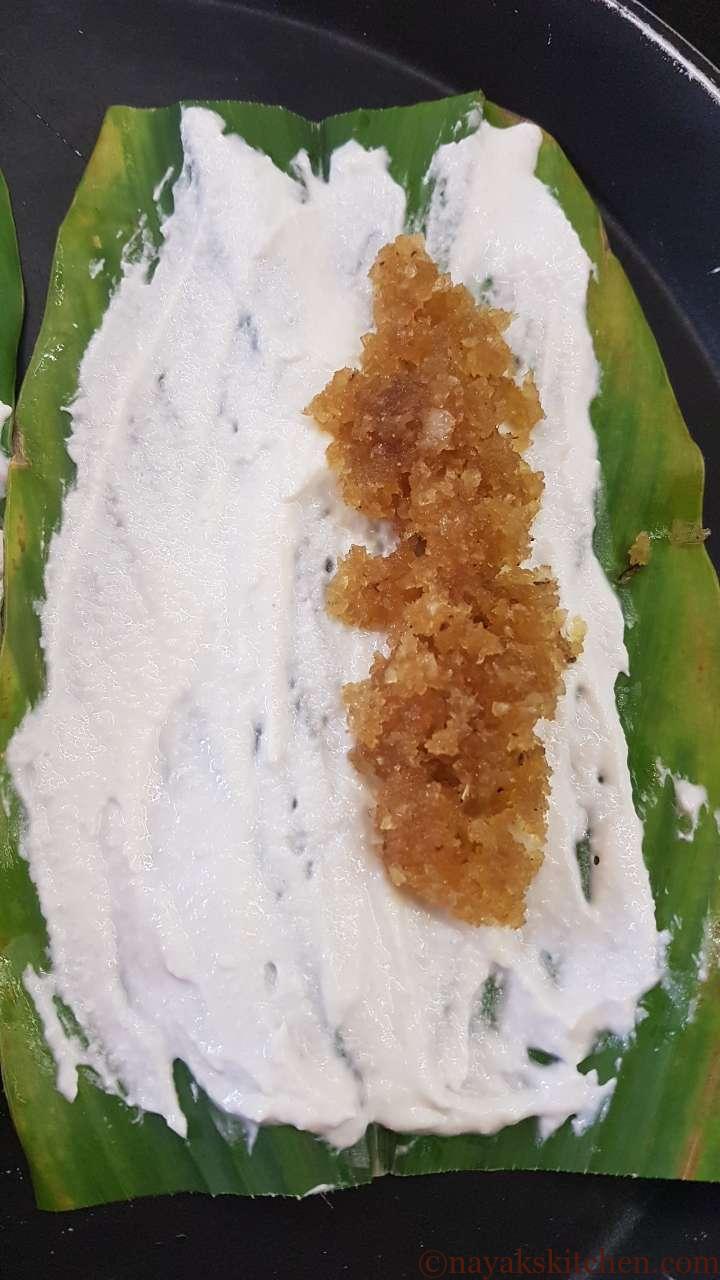
4. Fold the leaf onto one side and seal the edges. Do not press the jackfruit patholi too hard. Similarly, finish the remaining patoleo.

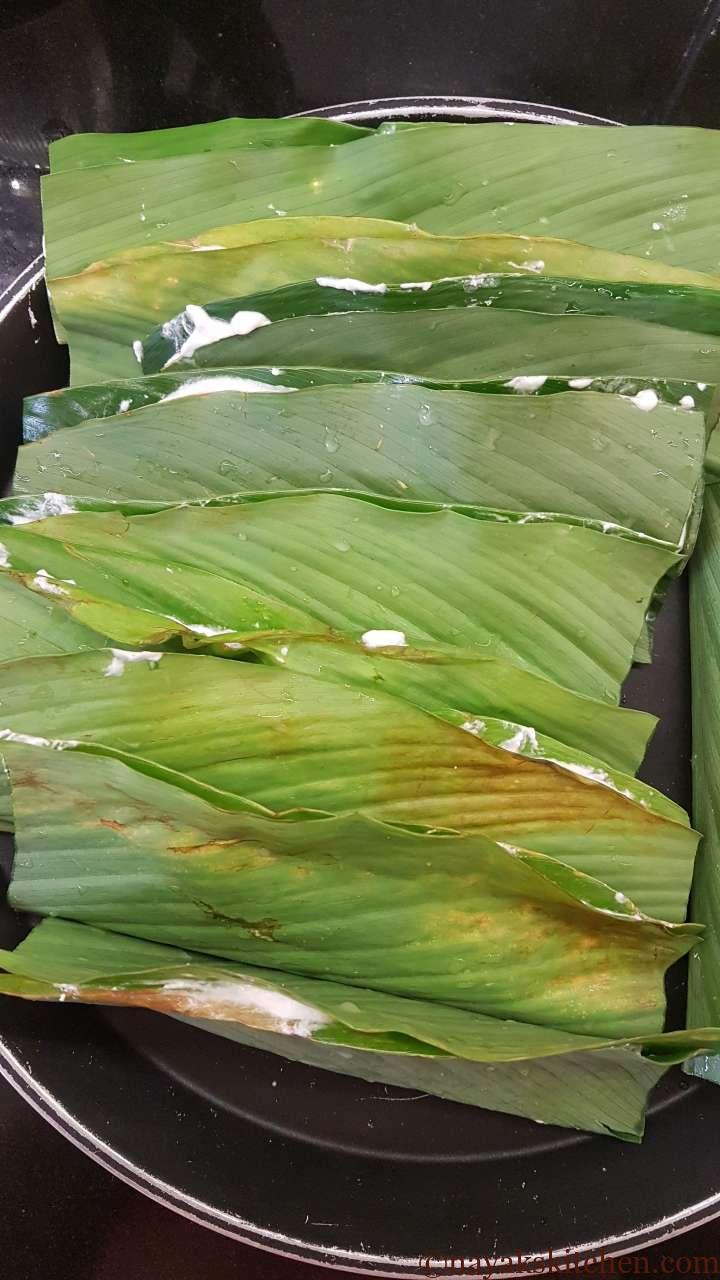
5. Carefully place the jackfruit patholis in the steamer. Their open ends should be facing up so that the jaggery does not leak. Steam the jackfruit patholis for about 20-25 mins. The bright green colour of the leaves should turn pale.
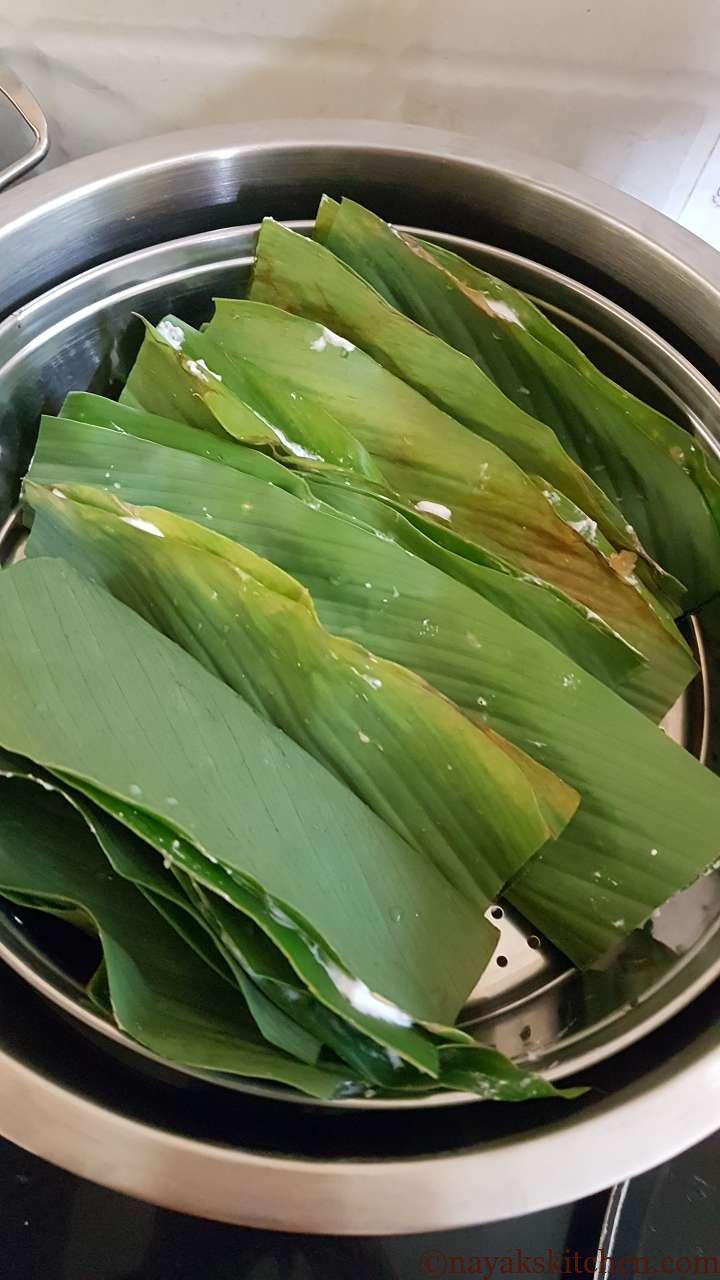

6. Discard the leaf and enjoy the jackfruit patholi hot with a tsp of ghee.
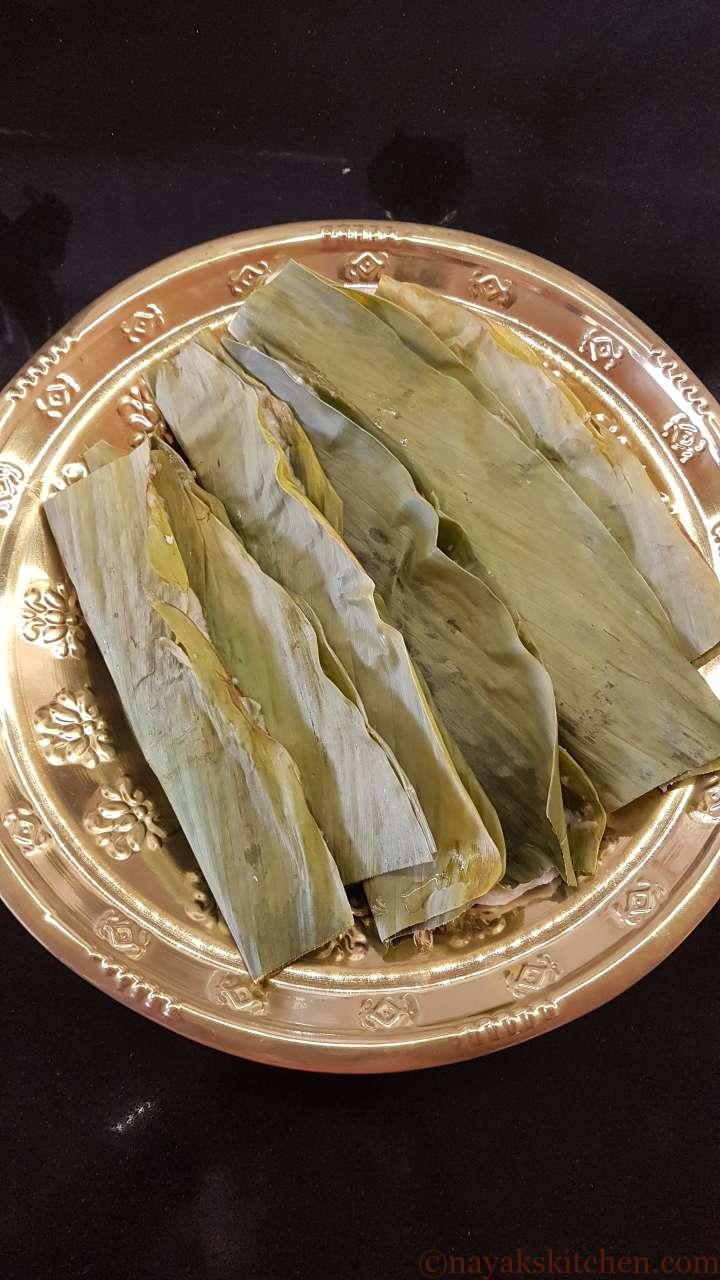

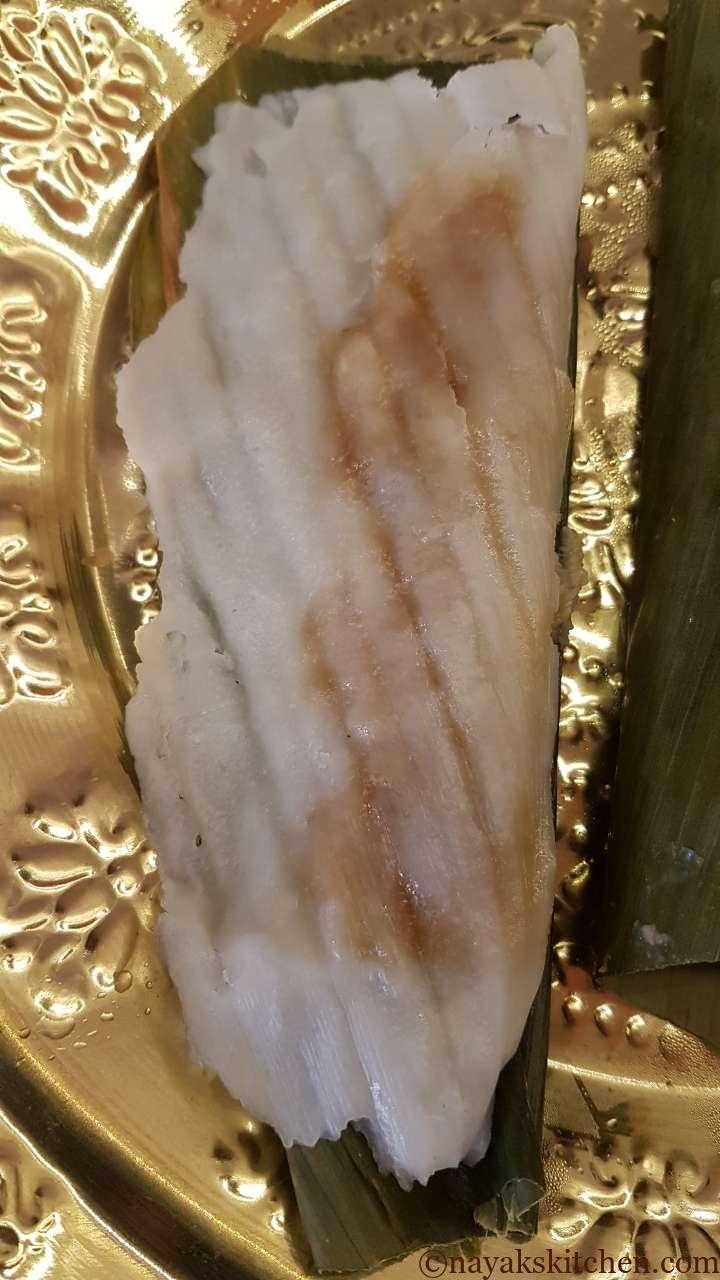
Jackfruit Patholi | Ponsa Patholi | How to store jackfruit?
Course: Indian SweetsCuisine: GoanDifficulty: Moderate25
servingsA twist to the traditional patholi with a subtle hint of jackfruit. Steamed rice wraps with a stuffing of coconut and jaggery.
Ingredients
1 cup = 250 ml
1 tbsp = 15 ml
1 tsp = 5 ml
Turmeric leaves – 25 nos.
Jackfruit pods – 15 nos
Rice – 1/2 kg
Water – 1/4 cup
Salt – 2 tsp
- For the Filling
Grated Coconut – 4 cups or 1 large coconut
Jaggery – 2 cups
Ghee – 1 tsp
Cardamom powder – 1/4 tsp
Salt – a pinch
Directions
- Soaking rice
- Clean the rice and remove any stones. Wash the rice with fresh water. Discard the water. Add water again and soak the rice for 7-8 hours or overnight.
- Preparing turmeric leaves
- Wash the turmeric leaves with fresh water and allow them to dry. You can wipe them dry too. Trim the edges of the leaves. Also, if the leaves are big you can cut them into two or three pieces. Note: You can use banana leaves instead if you do not have turmeric leaves.
- Do not discard the trimmed edges of turmeric leaves. You can use them in the steamer while steaming.
- Preparing the batter
- Remove the seeds from the jackfruit. Take the pods in a mixie jar and grind them to a pulp or paste.
- Drain the water from the rice completely. Add this rice to the mixie jar. Next, add salt and grind the jackfruit pulp and rice together to a paste. Add 1/4th cup water little by little while grinding. Do not add too much water.
- Grind the rice and jackfruit pulp together to get a thick batter. You should be able to spread the batter comfortably on the turmeric leaf.
- Preparing the stuffing/filling for jackfruit patholi
- Heat a kadhai and add jaggery to it.
- Let the jaggery melt till it turns into a liquid.
- Once the jaggery melts, add freshly grated coconut to it. Mix well.
- Add salt and ghee (clarified butter).
- Add cardamom powder and cook till everything blends well. Switch off the gas and allow the stuffing to cool completely.
- Preparing jackfruit patholi
- Keep all the ingredients ready. Trimmed turmeric leaves, coconut-jaggery stuffing and rice-jackfruit batter.
- Keep water for heating in a steamer while you prepare the patoleo. Add the trimmed edges of the turmeric leaves to the water. You can use an idli steamer.
- Smear the leaf with a thin layer of batter, moving from down to the top direction. Place the coconut-jaggery filling slightly towards the right of the leaf.
- Fold the leaf onto one side and seal the edges. Do not press the jackfruit patholi too hard. Similarly, finish the remaining patoleo.
- Carefully place the jackfruit patholis in the steamer. Their open ends should be facing up so that the jaggery does not leak. Steam the jackfruit patholis for about 20-25 mins. The bright green colour of the leaves should turn pale.
- Discard the leaf and enjoy the jackfruit patholi hot with a tsp of ghee.
Notes
- Preferably use the rasaal variety of jackfruit (called Barka fanas in Marathi) for this recipe.
- Rice – I have used Ambemohar rice for this recipe. You can use raw rice, sona masoori or ukde rice too.
- Jaggery – Use organic jaggery for the best flavour.
- Turmeric leaves substitute – You can use banana leaves as an alternative.
- If your batter becomes runny just add rice flour to make it thick.




